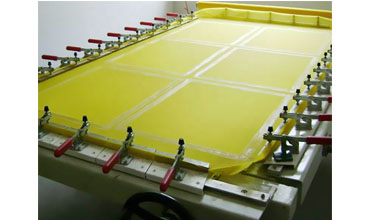Common faults and analysis of screen printing (Three)
Jan. 04, 2020
Fourth, uneven ink
The thickness of the ink film is uneven. There are various reasons. In terms of ink, the ink is poorly blended, or the normally blended ink is mixed into the ink skin. When printing, the solvent swells and softens due to the solvent. The mesh is blocked, which acts as a plate film and prevents the ink from passing through.
In order to prevent this kind of trouble, the mixed ink (especially the old ink) should be filtered with a mesh before use before use. When reusing a pre-printed plate, the old ink attached to the plate frame must be completely removed. When storing the printing plate after printing, wash it thoroughly (including the squeegee). If the above requirements are followed, the uneven ink accident will not occur.
If the tip of the front end of the scraper is damaged, a streak will appear along the moving direction of the scraper. Especially when printing transparent materials, there will be obvious uneven inking. Therefore, the front end of the scraper must be well protected from damage. If it is damaged, it must be carefully ground with a grinder.
The unevenness of the printing table will also affect the inking uniformity. The ink layer on the convex part is thin, and the ink layer on the concave part is thick. This phenomenon is also called uneven inking. In addition, if dust adheres to the back surface of the polyester screen printing mesh or the printing table, the above-mentioned failure may also occur.
Fifth, pinholes
The pinhole phenomenon is the most headache problem for screen printing staff. If it is the printing of opaque objects such as billboards and thick paper, such small holes that are not easily visible are generally not a problem. But mix it on aluminum, glass, acrylic. In addition, when the emulsion is applied, dust is also mixed in, and pinholes are generated on the screen. During the test, if you pay attention to the inspection, you can find and make timely repairs. If dust and foreign matter adhere to the printing plate, blocking the screen opening will also cause pinholes. Before the official printing, if the ink-absorbing paper is used for several sheets of printing, the dust can be removed from the plate.
Cleaning of substrate surface. Aluminum plate, glass plate, acrylic plate, etc. should be pre-treated to make their surface clean before printing. After the substrate has been pre-treated, it should be printed immediately. In multi-color printing, the method of rubbing with alcohol before printing is generally used. In addition, semi-automatic and full-automatic ultrasonic cleaning machines can also be used. After the pretreatment, dirt such as grease can be removed, and dust adhering to the surface can also be removed.
Polyester Screen Printing Mesh
Detergents for washing machines are often mixed with broken fibers, which are soluble in alcohol. When cleaning the surface of substrates, a thin film of surfactant is often formed, and pinholes occur when printing ink on the film. So pay special attention when using cleaning agents and alcohol.
When the substrate is carried by hand, the fingerprint of the hand is also attached to the printing surface, and pinholes are formed during printing.
Sixth, upsizing of the finished ink film
After screen printing, the print size may sometimes increase. The main reason for the increase in printing size is the low viscosity of the ink and the excessively large curvature. The increase in the size of screen printing plates during production by silk screen printing mesh supplier is also the reason for the increase in printing size.
In order to prevent the ink from overflowing to the surrounding surface after printing due to the excessive fluidity of the ink, which causes the printing size to increase, consider adding a certain amount of thickener to the ink with excessive fluidity to reduce the fluidity of the ink. Fast-drying ink, speed up the drying speed of ink after printing, and reduce the flow of ink. When making screen printing plates, the quality of the screen printing plates must be strictly guaranteed.








